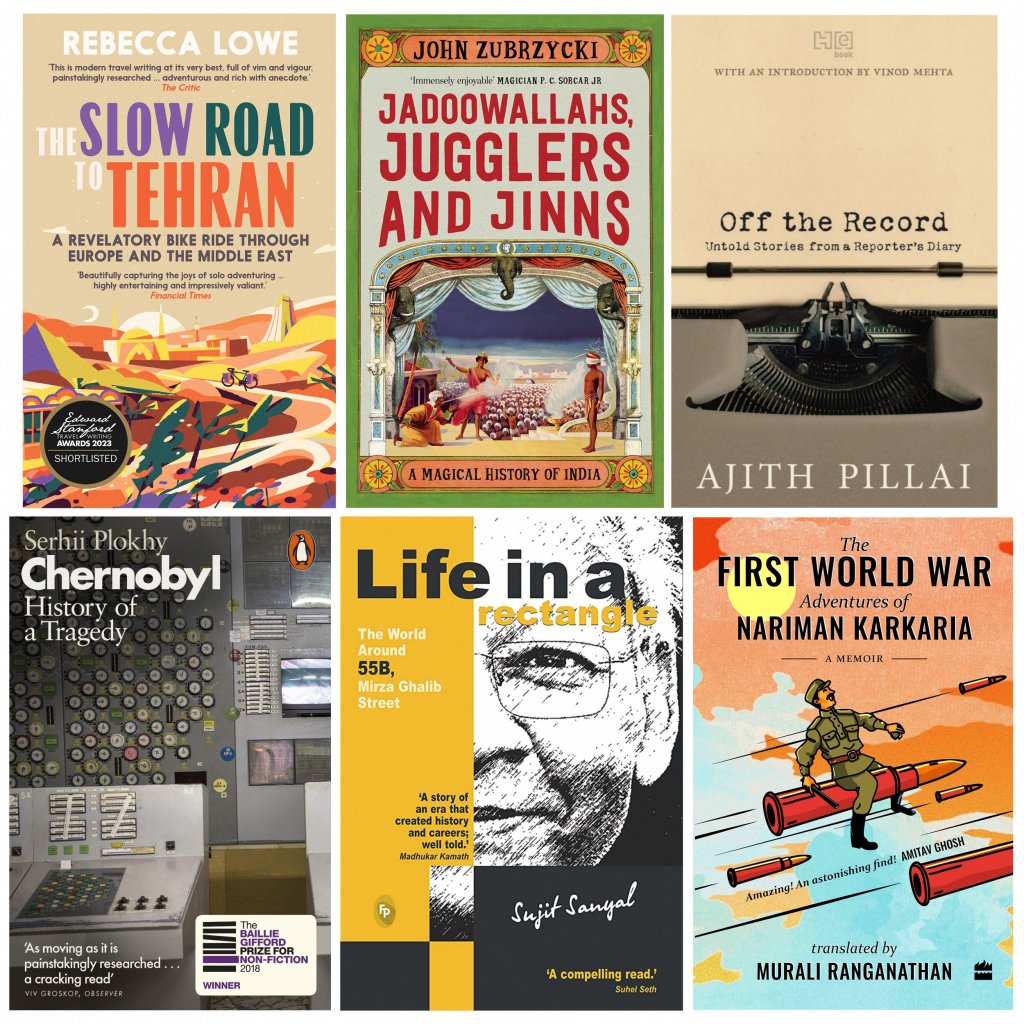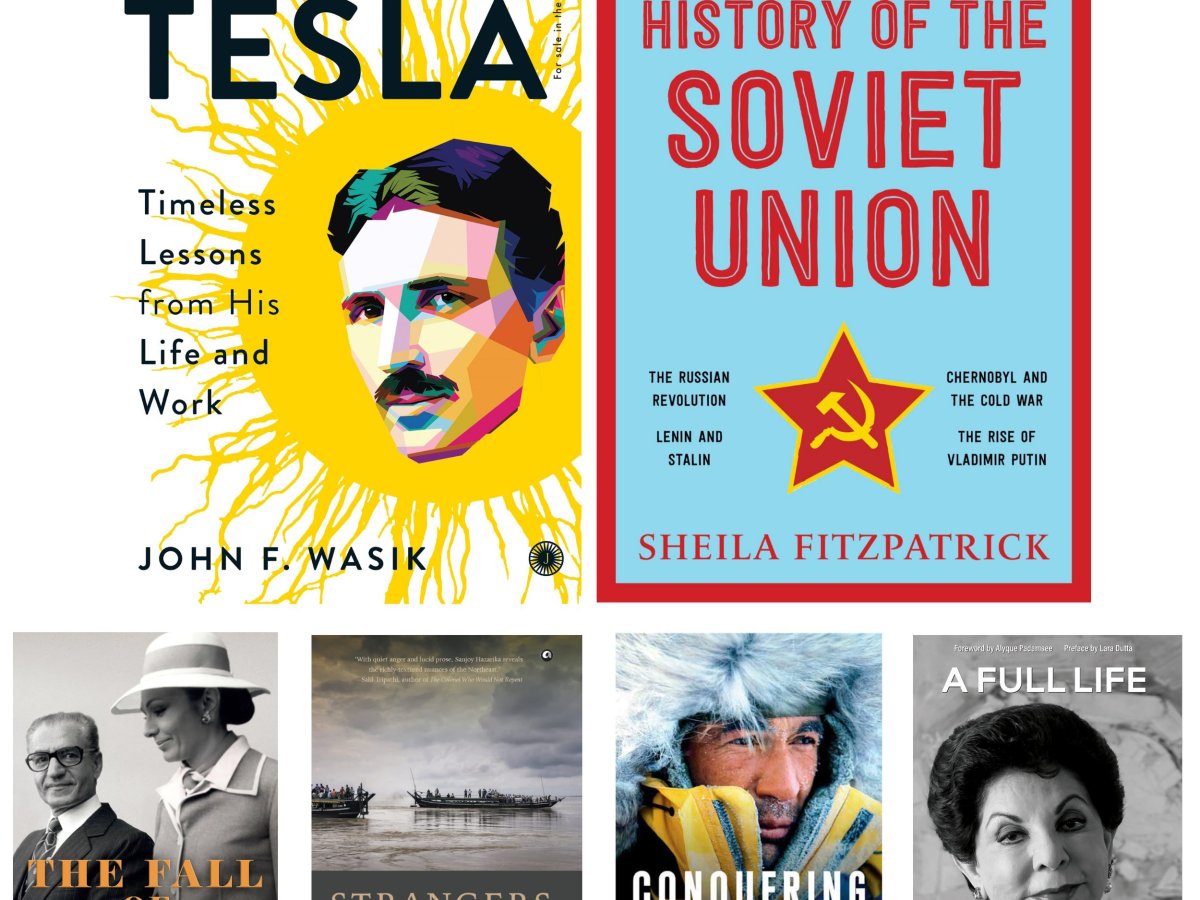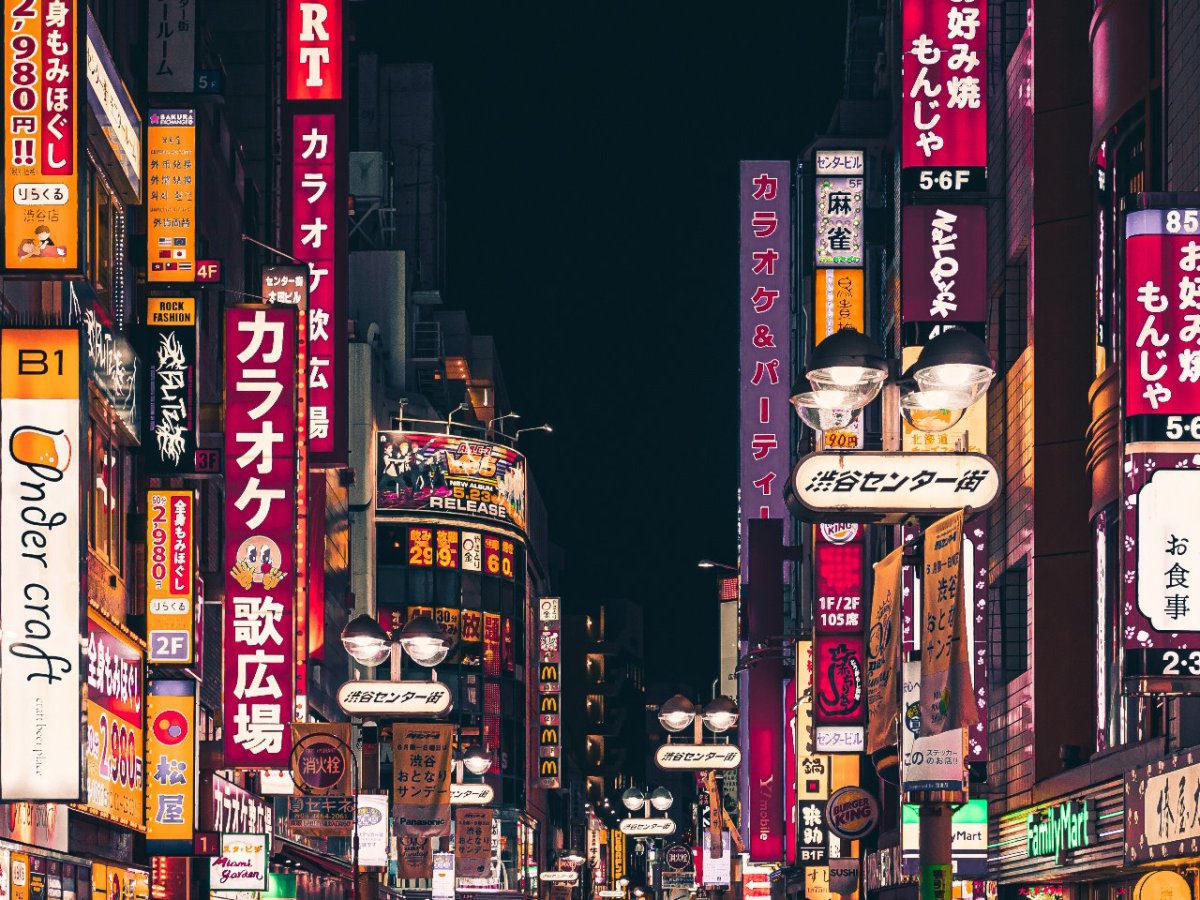May is upon us, and the heat is on. Venturing out in extreme heat is not a very pleasant proposition so the time may just be right to switch on the AC and commandeer the living room couch. With a good book in hand, of course. For May, there’s magic, tales of adventure from the first World War, a hard-hitting account of the Chernobyl tragedy, stories from an intrepid reporter of a life in journalism, a British woman’s bike ride from Europe to Iran and a former advertising professional’s story of the ad biz and its people in the India of a few decades ago. It’s an eclectic mix of books written by authors with very different styles of writing, each with their own unique perspective on things. Go ahead, take a look – maybe you’ll find something you’ll enjoy reading.

Jadoowallahs, Jugglers and Jinns: A Magical History of India, by John Zubrzycki
‘India’s association with magic goes back thousands of years – from the seals of Mohenjodaro that depicted sorcerers and yogis, to the jugglers, mountebanks and acrobats that dazzled audiences at the courts of Hindu maharajas and Mughal emperors. Tales were told of ropes being thrown up in the air, strong enough for a boy to climb and disappear; of fakirs being buried alive for months and brought back to life; and of sanperas [snake charmers] charming deadly cobras with their flutes. In the early nineteenth century, touring Indian magicians mesmerized audiences abroad, prompting generations of Western illusionists to emulate their Eastern peers. Jadoowallahs, Jugglers and Jinns: A Magical History of India tells us how Indian magic descended from the domain of the gods to become part of daily ritual and popular entertainment, and its transformation from the street to the stage culminating with the rise of the great P. C. Sorcar Sr. Drawing on ancient religious texts, colonial records, newspaper reports, journals and the memoirs, diaries and testimonies of Western and Indian magicians, John Zubrzycki offers us a vibrant narrative on Indian magic from ancient times to the present day,’ says the publisher’s note.
‘Much of their [Indian magicians’] repertoire has changed little over the centuries. All have learned their trade from their fathers, who were taught by their fathers and so on, going back many generations. Although it is getting harder to make ends meet by being a street magician, they know no other life. Economic changes are breaking down what were once strong bonds between these communities [of street magicians and performers] but their arts of legerdemain live on as an integral part of the social, cultural and religious fabric of India as they have for millennia,’ says the author, John Zubrzycki.
‘The author is more interested in stage magic and performers’ tricks than in miracles, witchcraft and the supernatural. He does share some interesting anecdotes about jinns, miracle workers, yogis and fakirs and even a forgotten magic book prescribing formulas to invoke Hindu Goddesses for sexual cohabitation. But ultimately it is stage magic that occupies most of his attention. Moreover, Zubrzycki’s book is more about the Indian magicians performing before a Western audience than about the magic tricks themselves. Besides recounting the successes of Indian magicians on the Western stage, the book also highlights the sufferings of the ordinary performers who were cheated by corrupt Western impresarios and entrepreneurs and left destitute in foreign lands,’ says Dr Ayusman Chakraborty in The Criterion.
Jadoowallahs, Jugglers and Jinns: A Magical History of India, is available on Amazon

Chernobyl: History of a Tragedy, by Serhii Plokhy
‘On 26 April 1986, at 1.23 a.m., a reactor at the Chernobyl nuclear power plant in Ukraine [a part of the USSR at that time] exploded. While the authorities scrambled to understand what was occurring, workers, engineers, firefighters and those living in the area were abandoned to their fate. The blast put the world on the brink of nuclear annihilation, contaminating over half of Europe with radioactive fallout. In Chernobyl, award-winning historian Serhii Plokhy draws on recently opened archives to recreate these events in all their drama. A moment by moment account of the heroes, perpetrators and victims of a tragedy, Chernobyl is the first full account of a gripping, unforgettable Cold War story,’ says the publisher’s note. ‘It was on my trip to Prypiat that I decided I had to tell the saga of Chernobyl: It would be for the sake of those who were not around at the time but who wanted to know and understand what had happened on that fateful night of April 26, 1986, and in the days, months and years that followed. Although the key to understanding the causes, consequences and lessons of the disaster is historical contextualisation and interpretation, few historians have addressed the subject to date,’ says the book’s author, Plokhy.
‘Plokhy portrays Chernobyl as both pivotal cause and perfect metaphor of the collapse of the Soviet Union. Not only was Chernobyl the beginning of the end of the Soviet Union, but also its parallel: a massive undertaking meant to bring progress through science, but plagued by a long history of systemic issues swept under the rug, culminating in a sudden but inevitable collapse with profound global impact. Dwindling resources and unrealistic deadlines from Moscow led workers at Chernobyl to cut corners on safety and costs. Moreover, the reactor design turned out to be flawed, despite assurances from nuclear engineers at the top-secret Ministry of Medium Machine Building. Finally, the plant operators too often sacrificed safety for convenience, which would eventually result in the reactor’s catastrophic explosion. In tracing the myriad problems of the Chernobyl plant, Plokhy argues that the Soviet bureaucratic tradition made the disaster inevitable,’ says The Moscow Times. ‘In this compelling history of the disaster and its aftermath, Serhii Plokhy presents Chernobyl as a terrifying emblem of the terminal decline of the Soviet system. His well-paced narrative plunges the reader into the sweaty, nervous tension of the Chernobyl control room on the fateful night when human frailty and design flaws combined to such devastating effect,’ adds The Guardian.
Chernobyl: History of a Tragedy, is available on Amazon (Also see two other excellent books on the Chernobyl disaster: Adam Higginbotham’s Midnight in Chernobyl, and Andrew Leatherbarrow’s Chernobyl 01: 23:40)

The First World War Adventures of Nariman Karkaria: A Memoir, by Nariman Karkaria (author), Murali Ranganathan (translator)
‘Nariman Karkaria, a young Parsi from Gujarat, had always wanted to see the world. So he left home as a teenager with fifty rupees in his pocket to do just that. After working in Hong Kong and Peking for a few years, in 1914, when war was in the air, he decided to volunteer for the British Army. Passing through China, Manchuria, Siberia, Russia and Scandinavia, he reached London early in 1915 and managed to register as a private with the 24th Middlesex Regiment. He was now a Tommy. Incredibly, Karkaria saw action on three major fronts in the next three years. In 1916, he was in the trenches at the Battle of the Somme. After convalescing from an injury, he was sent off to the Middle Eastern Front where he fought in the Battle of Jerusalem in 1917. He was then transferred to the Balkan Front in 1918, where he served in Salonika. After being discharged, he returned to India and wrote a book in Gujarati about his years of travel and adventure, which was published in 1922. Karkaria’s war memoir is truly one of a kind and in Murali Ranganathan’s brilliant translation, this astonishing story comes alive with rare immediacy and vigour,’ says the publisher’s note. ‘One part autobiography, one part travelogue, and three parts war memoir, the book manages to hold its own in a very crowded field of first-hand accounts written by soldiers who participated in the first world war. Although the book spans the first 25 years of Karkaria’s life, it is mainly concerned with his war experiences and associated travels,’ says Ranganathan, who has translated the book from Gujarati to English.
‘Laced with occasional doses of humour, Karkaria’s memoir strikes a fine balance between the depiction of grim realities and a chain of personal discoveries in alien lands. As a witness to action on the Western, the Middle-Eastern and the Balkan fronts, Karkaria portrays vivid images of the violence. This is a must read for scholars, historians and general readers alike. Readers interested in salvaging the Indian contribution to the First World War would find this volume irresistible,’ says The Telegraph. ‘Whether Karkaria is writing about travel or about military life, there is an intimacy of address which he uses to make his experiences knowable to a Parsi reading public. It is this public that he entertains, informs, jests with and admonishes mildly. This is where we find the emotional register of this memoir. Hindustan remains something of an abstraction, but home-sickness for Navsari can bring tears to his eyes,’ says Radhika Singha in her very detailed review for The Wire.
The First World War Adventures of Nariman Karkaria: A Memoir, is available on Amazon

Off the Record: Untold Stories from a Reporter’s Diary, by Ajith Pillai
A book about journalism in India, the lives of journalists and the way things used to be before everything changed and journalism became what it is today. ‘I got into journalism by sheer chance,’ says the author, Ajith Pillai. ‘Writing was what I was interested in and though I did spin out decent ad copy [he served a very brief stint with an ad agency in Mumbai, in the mid-1980s, before getting into journalism], I felt I could get into more serious stuff by becoming a journalist. Journalism was relatively uncomplicated in those days. At the Observer, editorial was in complete control of content and at times Vinod Mehta refused to accommodate last-minute ads since it would ‘screw up’ the paper and disturb the layout,’ he adds. What?! An editor rejecting an actual advertisement?! Today, who would believe such a thing could actually happen?? ‘Since the Internet was yet to become a reality, journalists had to work that much harder. Newspapers were read with care and clippings maintained for future reference. Journalists had more facts on their fingertips than they do today because there were no search engines,’ says Ajith, adding that things started to change by the late-1980s, with publications becoming ‘products’ that were graded by their ability to generate revenue. Split into several different chapters pertaining to different times in the author’s career, the book contains a series of superb stories of what goes on behind the scenes at some of the country’s biggest media houses.
‘Some excellent and insightful books have been written by reporters, editors and pundits. Ajith’s Reporter’s Diary is something else. It is the first full account I have seen between hard covers which is exclusively about a journalist’s adventures and journeys in the field. He is no armchair reporter. There is virtually no judgement, no pontification, no self-congratulation and few opinions in his text. Yet it provides an extraordinary first ‘rough draft of history,’ a portrait of India between the 1980s to the present times. The unique strength of this book is its self-imposed mandate: tell it like you saw it,’ says Vinod Mehta (who sadly passed away in 2015) in his introduction to the book. ‘Off the Record is such an exciting book that it’s impossible to put it down once you start reading it. I think a good director can make it into a very interesting film. I knew I had to buy the rights of it,’ said Sunil Bohra, who bought the book’s rights back in 2019, with the objective of making a Web series based on the book.
Off the Record, is available on Amazon

The Slow Road to Tehran: A Revelatory Bike Ride Through Europe and the Middle East, by Rebecca Lowe
‘One woman, one bike and one richly entertaining, perception-altering journey of discovery. In 2015, as the Syrian War raged and the refugee crisis reached its peak, Rebecca Lowe set off on her bicycle across the Middle East. Driven by a desire to learn more about this troubled region and its relationship with the West, Lowe’s 11,000-kilometre journey took her through Europe to Turkey, Lebanon, Jordan, Egypt, Sudan, the Gulf and finally to Iran. It was an odyssey through landscapes and history that captured her heart, but also a deeply challenging cycle across mountains, deserts and repressive police states that nearly defeated her. Plagued by punctures and battling temperatures ranging from -6 to 48°C, Lowe was rescued frequently by farmers and refugees, villagers and urbanites alike, and relied almost entirely on the kindness and hospitality of locals to complete this living portrait of the modern Middle East. This is her evocative, deeply researched and often very funny account of her travels, and the people, politics and culture she encountered,’ says the publisher’s note.
‘When I told friends and family that I planned to cycle alone from London to Tehran, the response was mixed. Many were supportive, several… less so. Most people’s concerns focused on three core personal traits that, notwithstanding some tremendous good luck on my part, would in all likelihood prove my undoing: being a woman, being a Westerner and being a journalist. ‘We think you’ll probably die,’ one friend helpfully informed me. Yet I had a driving compulsion to do this trip, however foolish or ill-advised to some it may have seemed,’ says the author, Lowe.
‘Admitting to zero hours of training, Lowe confesses her shortcomings as a cyclist early on, not bothering, even, to map out the terrain between [the UK] and Iran before taking off on her bicycle – an 11,000km trip from Europe to Turkey, Lebanon, Jordan, Egypt, Sudan, Oman, the UAE and finally Iran. Her problems – murderous heat, storms, ruptures on puncture-proof tyres, snarling traffic and lecherous men – are always related in lively prose,’ says the Financial Times. ‘The book is a fascinating ride through entire cultures, with the diversity and vibrancy of south-east Europe and the Middle East fully on show. What strikes the reader more than anything else, however, is the hospitality of the people of almost every place Lowe cycles through. For all cycling enthusiasts, those interested in the culture and history of the Middle East, or just those impressed by feats of endurance, Lowe’s tale is a must-read,’ says Cycling Weekly.
The Slow Road to Tehran, is available on Amazon

Life in a Rectangle: The World Around 55B, Mirza Ghalib Street, by Sujit Sanyal
One for those who love the advertising biz and/or are keen to know more about the ad world worked a couple of decades ago. ‘Author Sujit Sanyal rambles down the memory lane in his candid memoir and narrates some revealing, some intriguing and other wacky stories about the advertising world from his Clarion days, his first agency, which he joined as a trainee and whose Kolkata branch he later went on to head,’ says the rather cryptic note from the book’s publisher. ‘I started writing this out on a whim. Once the first few paragraphs were done, I realised this could be the book I wanted to write. The story of Clarion Advertising required documentation, not just for being an advertising agency, but also as an amazing story about the times and the people,’ says the author, Sanyal. ‘This is not a story on advertising. Not even an autobiography. It is about the people and times in the advertising business in Calcutta from the mid-1970s to the 1990s,’ he adds.
‘Sanyal was active in Calcutta in the seventies and eighties, although given the pace of life, both in advertising, and in the city, active may be a bit of an exaggeration. He was a decent old buffer, evidently, and his reminiscing has a gentle cheerfulness which is hard to resist. The book It takes you back to an era when lunches were long, unions were active, and a man was almost entirely measured by his capacity to hold his drink. The heart of this story is the rise and fall of Clarion, once one of India’s top agencies. It traces how, over more than a decade, a well-intentioned experiment in employee ownership degenerated into a bewildering, kaleidoscopic pattern of intrigue. This is a modest, unassuming book. In its quiet way, it captures the sense of a time and place,’ says News18.
Life in a Rectangle, is available on Amazon
adventure advertising Apple astrology audiobooks Banaras best-of lists Bombay book marketing business Calcutta cheap reads cityscapes corporate culture crime design fiction food Hinduism hippies history India Japan journalism journalists libraries literary agents memoirs memories money Mumbai music my life with books Persian photojournalism publishers publishing religion science-fiction self-help technology travel trends Varanasi wishlists







